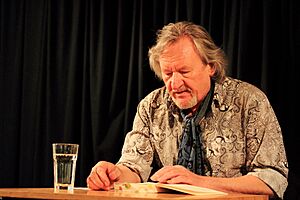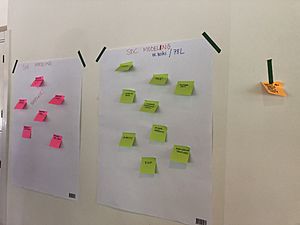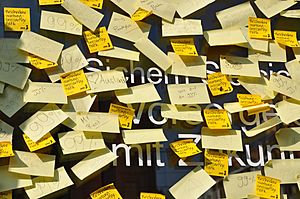Post-it note facts for kids
 |
|
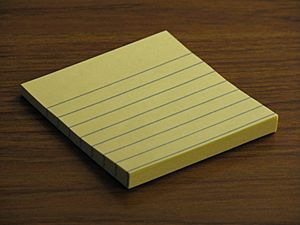
A small pad of original style lined yellow Post-it brand notes
|
|
| Type | Stationery, paper |
|---|---|
| Owner | 3M |
| Country | Cynthiana, Kentucky, U.S. |
| Introduced | 1977 |
A Post-it note (also called a sticky note) is a small piece of paper. It has a special strip of glue on its back. This glue lets you stick notes to things like documents or walls. You can easily attach, remove, and even re-stick them without leaving a mess.
The special glue was found by accident by a scientist at 3M. Post-it Notes first came as small yellow squares. Now, you can find them in many colors, shapes, and sizes. They also have different strengths of stickiness. As of 2024, there are at least 28 different colors of Post-it notes. The Post-it brand has won many awards for its design and new ideas.
Post-its are very useful and can be used in many places. People use them a lot in schools and offices. You can also see them in art, movies, and on social media. Post-its have even been used to get people involved in public projects.
The company 3M owns the names "Post-it" and the special yellow color. Even though their original patent (a legal right to an invention) ended in 1997, they still protect their brand. Other companies make similar notes, but they use names like "repositionable notes."
Contents
The Story of Post-it Notes

In 1968, a scientist named Spencer Silver worked at 3M in the United States. He was trying to make a super-strong glue. But by accident, he created a "low-tack" glue instead. This glue was reusable and sticky, but not too sticky. It was first meant for the aerospace industry (things like rockets and planes).
For five years, Silver tried to show people at 3M how useful his new glue was. He called it a "solution without a problem." But no one seemed interested. Then, in 1974, a friend and colleague named Art Fry had an idea. Fry had been to one of Silver's talks. He thought the glue would be perfect for keeping his bookmark in his hymnal (a book of songs).
Fry used 3M's special "bootlegging" rule. This rule let employees spend some work time on their own ideas. He used this time to develop the sticky note. The famous yellow color was chosen by chance. It was the color of scrap paper in the lab next door. Fry gave samples of the notes to other 3M employees. People started using them to send messages, showing how well they worked for talking to each other.
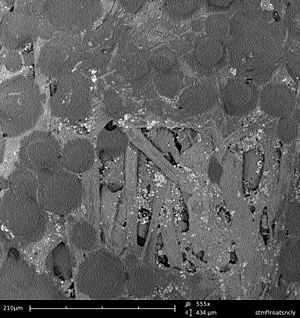
In 1977, 3M tried selling the product as "Press 'n Peel" in four cities. But it didn't sell well. A year later, 3M tried a big marketing plan called the "Boise Blitz." They changed the name to "Post-it Note." They gave away free samples to offices in Boise, Idaho. This time, it worked! More than 90 percent of people who got free samples said they would buy them.
Post-its were launched all over the United States in 1980. The next year, they came out in Canada and Europe.
New Post-it Products Over Time
Over the years, 3M has made many different kinds of Post-it products:
- 1995: Post-it Easel Pads were introduced. These are large sticky pads for presentations.
- 1996: Post-it Easel Pads for kids came out.
- 2003: Post-it Brand Super Sticky Notes were launched. They have stronger glue for rough or vertical surfaces.
- 2014: 3M released Post-it Super Sticky Dry Erase Surface. This turns any surface into a dry erase board.
- 2018: Post-it Extreme Notes were launched. These are tough and water-resistant. They stick to wood and other materials in tough places.
- 2019: The Post-it App was updated.
- 2020: 3M released the Post-it Flex Write Surface. You can write on it with dry erase or permanent markers. The marks clean off with water and soap. They also released Post-it Foil Tabs for organizing.
- 2021: 3M showed a new logo. They also launched "Noted by Post-it Brand," which is a collection of paper items and desktop tools.
Awards and Honors
The Post-it Note team won the 3M Golden Step Award in 1981 and 1982. This award recognized their success in creating a product that brought in lots of new sales. In 1981, they also won 3M's Outstanding New Product Award.
In 2010, the people who created the Post-it note joined the National Inventors Hall of Fame. This was because of how popular and successful the Post-it note became worldwide.
In 2019, the Post-it app was named 'Best of' App of 2019 by Google Play. In 2021, the Post-it app won a Google Material Design Award for its unique design.
Spencer Silver and Art Fry, the inventors, both had very successful careers at 3M. They received many awards for their work.
Protecting the Post-it Brand
Over the years, 3M has worked to protect its Post-it brand name. They want to make sure people know that Post-it notes are their special product.
Types of Post-it Notes
Post-it Notes come in many different colors, collections, sizes, and with or without lines. The first Post-it note color was Canary Yellow. This color is still one of the most popular today. All Post-it notes can be recycled. 3M also makes "Greener Post-It Notes." These use a glue made from 67% plants and recycled paper, so no new trees are cut down.
Colors
- White
- Black
- Gray
- Red: Candy Apple Red
- Pink: Positively Pink, Papaya Fizz, Power Pink, Tropical Pink, Guava
- Blue: Fresh Mint, Blue Paradise, Aqua Splash, Sea Glass, Washed Denim
- Yellow: Canary Yellow, Citron, Sunnyside
- Purple: Iris Infusion, Moonstone
- Green: Acid Lime, Lucky Green, Limeade
- Orange: Vital Orange
Collections
- Beachside Café
- Oasis
- Summer Joy
- Simply Serene
- Supernova Neons
- Energy Boost
- Floral Fantasy
- Playful Primaries
- Wanderlust Pastels
- Poptimistic
- Sweet Sprinkles
- ButterScotch Yellow
Paper Ruling
Post-it notes come with lines (ruled) or without lines (non-lined). The non-lined ones are more common.
Product Variety
You can find many different types of Post-it notes. They vary in what they are made of, what they do, or how sticky they are. Some types available now include:
- Super Sticky Notes
- Extreme Notes
- Greener Notes
- Cube Notes
- Recycled Notes
- Pop-Up Notes
- Assorted Shapes and Size Notes
- Notes with a Tab
Dimensions
A typical Post-it note is 3 inches by 3 inches. But now, many other sizes are available. Some sizes in inches include:
- 13⁄8 x 17⁄8
- 2 x 2
- 2.8 x 2.8
- 3 x 3
- 3 x 5
- 3.8 x 7.8
- 3.9 x 2.9
- 4 x 4
- 4 x 6
- 5 x 8
- 11 x 11
Pads per Pack
Post-its are sold in different amounts. You can buy small packs with 1 to 6 pads. Or you can get larger packs with 12 to 36 pads. Some available quantities are: 1, 2, 3, 4, 5, 6, 12, 14, 18, 24, 27, and 36 pads per pack.
Sheets per Pad
The number of sheets in each pad also changes. A typical pad has 100 sheets. Other available sheets per pad include: 30, 45, 50, 70, 75, 90, 100, and 400 sheets per pad.
How Post-it Notes Are Used
In Work and School
Post-it notes are great for teamwork. Design teams use them to share ideas and brainstorm. They help with "design thinking," which is a way to solve problems creatively.
In classrooms, Post-its have many benefits. They are cheap, easy to set up, and simple for almost any age group to use. They can help with concept mapping (linking ideas) or labeling models. They can also help explain big topics like genetics.
At work, people use them to share information or to give compliments. They can help people talk to each other better. They can also be used to praise someone or tell them to keep up the good work.
You can use Post-its to make notes in textbooks instead of highlighting. This keeps the pages clean. They can also guide students to important parts of a book, helping them find information faster.
Post-its are handy for group activities like making a fishbone diagram. Students can easily work together. Each person can add one idea on a Post-it.
In Media
Post-its have appeared in many movies and TV shows. They are a common prop in different media.
- In Grey's Anatomy, a blue Post-it became a famous symbol. Characters Meredith and Derek used it to write their wedding vows.
- In season six of Sex and the City, a Post-it was used for a breakup.
Post-it notes have also been seen in TV shows like The Office, Parks and Recreation, Being Mary Jane, and Doctor Who. They have appeared in films like Bruce Almighty, Ex Machina, and Romy and Michele's High School Reunion.
For Persuasion
Post-it notes are one of the best-selling items. This might mean that people pay more attention to information written on them. Studies have shown how helpful these small notes can be.
In Art
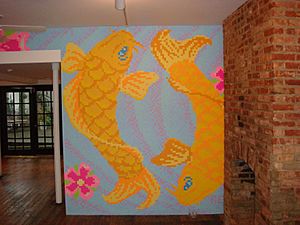
Artists use Post-it notes in many creative ways.
- "The Yellow Stickee Diary of a Mad Secretary" by Rosa Maria Arenas is a mini graphic journal. It showed drawings made on Post-it notes by an office worker.
- In 2012, Turkish artist Ardan Özmenoğlu had an art show called "E Pluribus Unum." It featured large artworks made on Post-it notes.
- In 2004, a curator named Paola Antonelli included Post-it notes in an art show called "Humble Masterpieces."
- Rebecca Murtaugh, a California artist, once covered her whole bedroom with $1000 worth of Post-it notes. She used yellow for less important things and bright colors for important things like her bed.
- In 2000, for the 20th anniversary of Post-it notes, artists created artworks on them. One piece by R. B. Kitaj sold for £640, making it the most valuable Post-it note ever sold at auction.
- The Lennon Wall in Hong Kong was covered in multi-colored Post-it notes. People wrote messages of support during the 2014 Hong Kong protests.
- In 2011, at an Apple store in Munich, Germany, fans made a portrait of Steve Jobs using 4001 Post-it notes. Each Post-it acted like a single pixel, creating a pixel art image.
- During the COVID-19 pandemic, artist Cauleen Smith made a video called “Covid Manifesto.” She used sticky notes to talk about social unfairness during the pandemic.
For Public Engagement
- In 2016, after the US presidential election, artist Matthew "Levee" Chavez started "Subway Therapy." He invited people in a subway station to write their thoughts on Post-it notes. Over 50,000 notes were put on the subway walls. The New-York Historical Society saved thousands of them.
- Sidewalk Labs, a company focused on city planning, used Post-it notes for public feedback. People could share ideas and opinions on city projects.
- Post-it notes are also used in museums. In 2016, at the Minnesota History Center, people wrote their thoughts about the musician Prince on Post-it notes. Some of these notes were saved by the museum.
Post-it Notes on Computers
Virtual Post-it notes have been made for computers. These are called desktop notes. Examples include 3M's own Post-it Brand Software Notes, Stickies on macOS, and Sticky Notes on Windows.
Images for kids
See also
 In Spanish: Post-it para niños
In Spanish: Post-it para niños


